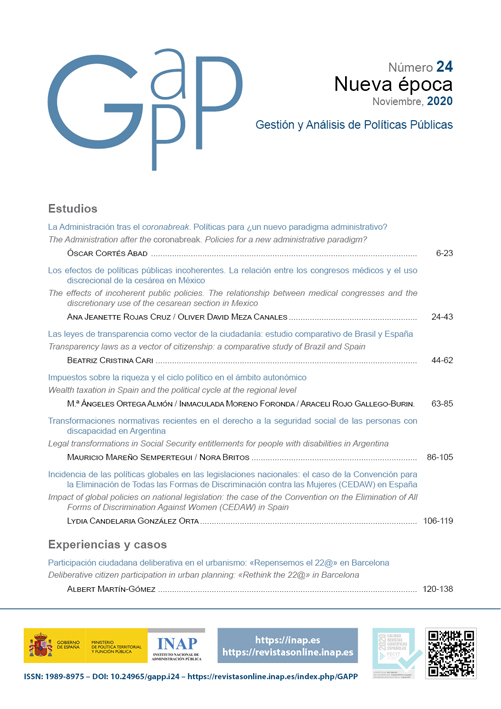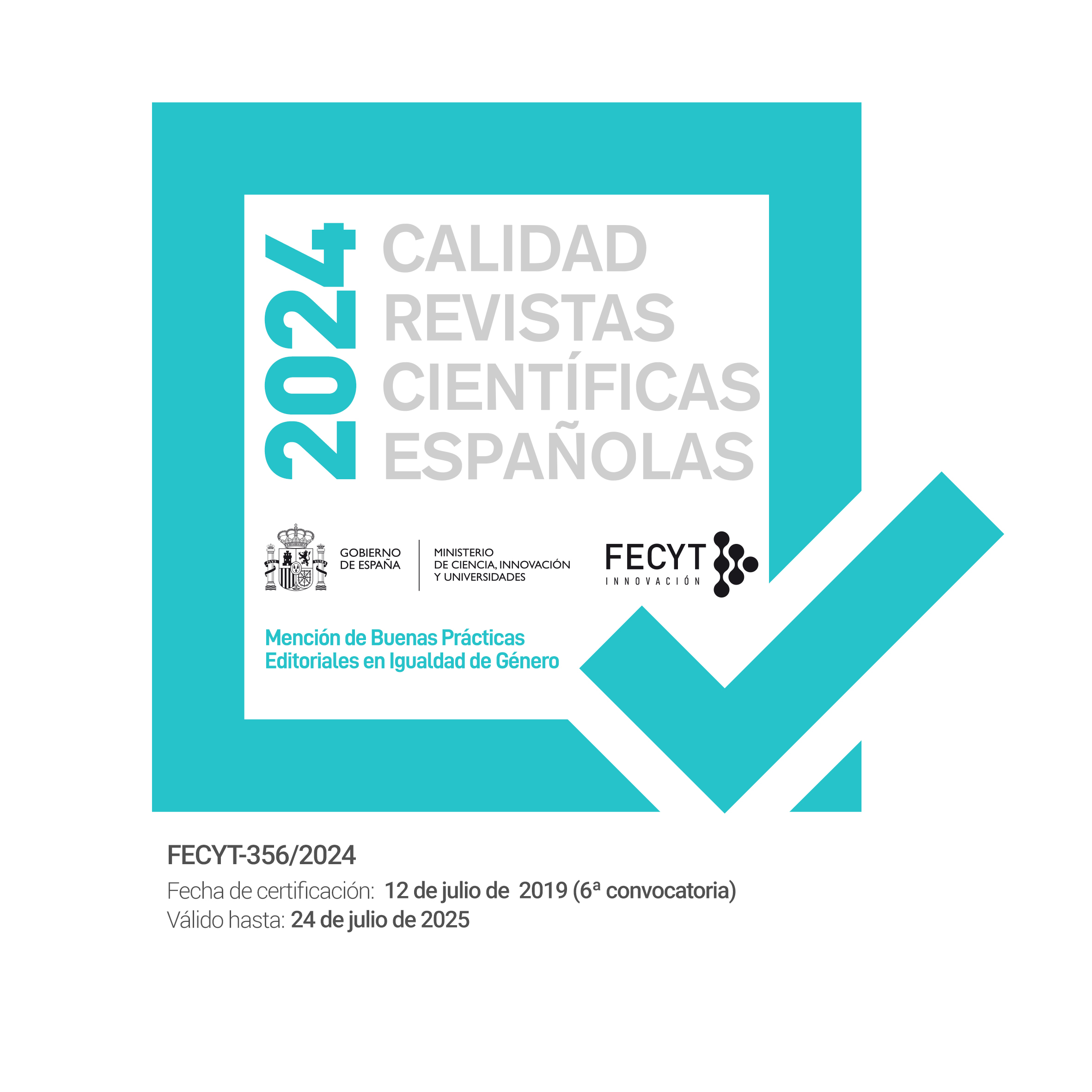The effects of incoherent public policies. The relationship between medical congresses and the discretionary use of the cesarean section in Mexico
DOI:
https://doi.org/10.24965/gapp.i24.10792Keywords:
Public policy, policy coherence, policy design, cesarean section, multiple regressionAbstract
In this research we discuss the importance of putting emphasis on public policies that are incoherent with each other, in terms of State effectiveness. We use the case of the practice of caesarean section in Mexico to understand how the phenomenon can be partially explained from incoherence between instruments of the Mexican government’s health policy. We asked to what extent the holding of gynecology and obstetrics medical congresses, as part of a certification process, is related to the practice of caesarean sections, within the framework of a policy that attempts to limit the discretionary use of caesarean section in Mexico? We argue that the objectives of one policy are affected by the instruments of another policy, and that therefore the discretionary use of this birth method is associated with the incoherence experienced from the physical presence that requires certification through congresses. To demonstrate this, we calculated the rate of caesarean sections per day from 2008 to 2015, and we tracked the dates of the national gynecology and obstetrics congresses for the same period of time. We determine the statistical association between both events from a multiple regression analysis. The result is that there is a statistical association between the rate and the existence of congresses, supporting the argument of incoherence. The conclusions propose some policy ideas to mitigate this problem in particular, and in general to address the inconsistency between policies.
Downloads
References
AGUILAR, L. F. (2009): “Marco para el análisis de las políticas públicas”, en MARIÑEZ, F. y GARZA, V. (coords.): Política pública y democracia en América Latina: Del análisis a la implementación, págs. 11-33. México: Miguel Ángel Porrúa.
BELTRÁN, A. P.; YE, J.; MOLLER, A.-B.; ZHANG, J.; GÜLMEZOGLU, A. M.; TORLONI, M.ª R. (2016): “The Increasing Trend in Caesarean Section Rates: Global, Regional and National Estimates: 1990-2014”, en PLoS ONE, vol. 11, núm. 2, e0148343. DOI: https://doi.org/10.1371/journal.pone.0148343.
BERNAL-GARCÍA C.; NAHÍN-ESCOBEDO, C. C. (2018): “Cesárea: situación actual y factores asociados en México”, en Salud Quintana Roo, vol. 11, núm. 40, págs. 28-33. URL: https://www.medigraphic.com/cgi-bin/new/resumen.cgi?IDARTICULO=92469.
BLOUIN, C. (2007): “Trade Policy and Health: From Conflicting Interests to Policy Coherence”, en Bulletin of the World Health Organization, vol. 85, núm. 3, págs. 169-173. DOI: https://doi.org/10.2471/blt.06.037413.
BURNS, L. R.; GELLER, S. E.; WHOLEY, D. R. (1995): “The effect of physician factors on the caesarean decision”, en Medical Care, vol. 33, núm. 4, págs. 365-382. https://doi.org/10.1097/00005650-199504000-00004.
CEJUDO, G. M.; MICHEL, C. L. (2015): “Resolviendo problemas sociales complejos mediante la integración de políticas. El caso de la Cruzada Nacional contra el Hambre en México”, en Revista del CLAD Reforma y Democracia, núm. 63, págs. 33-64. URL: http://old.clad.org/portal/publicaciones-del-clad/revista-clad-reforma-democracia/articulos/063-octubre-2015/Cejudo.pdf.
CEJUDO, G. M.; MICHEL, C. L. (2017): “Addressing fragmented government action: coordination, coherence, and integration”, en Policy Sciences, vol. 50, págs. 745-767. DOI: https://doi.org/10.1007/s11077-017-9281-5.
CEJUDO, G. M.; MICHEL, C. L. (2016): “Coherencia y Políticas Públicas. Metas, instrumentos y poblaciones objetivo”, en Gestión y Política Pública, vol. 25, núm. 1, págs. 3-31. DOI: http://dx.doi.org/10.29265/gypp.v25i1.149.
CHRISTENSEN, T.; LÆGREID, P. (2008): “The Challenge of Coordination in Central Government Organizations: the Norwegian Case”, en Public Organization Review, vol. 8, núm. 2, págs. 97-116. DOI: https://doi.org/10.1007/s11115-008-0058-3.
CROWLEY, K.; HEAD, B. W. (2017): “The enduring challenge of «wicked problems»: revisiting Rittel and Webber”, en Policy Sciences, vol. 50, núm. 4, págs. 539-547. DOI: https://doi.org/10.1007/s11077-017-9302-4.
COMITÉ NORMATIVO NACIONAL DE CONSEJOS DE ESPECIALIDADES MÉDICAS A. C. (CONACEM) (2017): Reglamento de Idoneidad. Revisado en septiembre 2017. URL: https://conacem.org.mx/index.php/marco-juridico/reglamento.
CONSEJO MEXICANO DE GINECOLOGÍA Y OBSTETRICIA A. C. (CMGO) (2017): Estatutos de la Asociación. Revisado en septiembre 2017. URL: https://cmgo.org.mx/assets/estatutos_cmgo_2020.pdf.
CONSEJO MEXICANO DE GINECOLOGÍA Y OBSTETRICIA A. C. (CMGO) (2017): Examen de certificación. Revisado en septiembre 2017. URL: https://www.cmgo.org.mx/certificacion.html.
CONSEJO MEXICANO DE GINECOLOGÍA Y OBSTETRICIA A. C. (CMGO) (2017): Cedula de Vigencia de Certificación. Revisado en septiembre 2017. URL: https://cmgo.org.mx/assets/cedula_vigencia_certificacion_2019.pdf.
ESTADOS UNIDOS MEXICANOS (2015): “Acuerdo por el que se emiten los Lineamientos a los que se sujetarán el Comité Normativo Nacional de Consejos de Especialidades Médicas y los Consejos de Especialidades Médicas a los que se refiere el art. 81 de la Ley General de Salud”, en Diario Oficial de la Federación, 25 de marzo de 2015. Revisado en enero 2018. URL: https://www.dof.gob.mx/nota_detalle.php?codigo=5386686&fecha=25/03/2015.
DIRECCIÓN GENERAL DE INFORMACIÓN EN SALUD DE MÉXICO (2017): Datos Abiertos-Nacimientos. Revisado en julio 2017. URL: http://www.dgis.salud.gob.mx/contenidos/basesdedatos/da_nacimientos_gobmx.html.
ELIZALDE GONZÁLEZ, J. J. (2017): “Congresos médicos. La importancia de participar”, en Medicina Crítica, vol. 31, núm. 6, págs. 318-319. URL: https://www.medigraphic.com/pdfs/medcri/ti-2017/ti176a.pdf.
FEDERACIÓN MEXICANA DE COLEGIOS DE OBSTETRICIA Y GINECOLOGÍA A. C. (FEMECOG) (2017): Inicio. Revisado en septiembre 2017. URL: https://femecog.org.mx/.
GONZÁLEZ-PÉREZ, G. J.; GUADALUPE VEGA, M.ª; CABRERA, C. (2011): “Factores socio epidemiológicos y de la organización de los servicios de salud asociados a la operación cesárea”, en GONZÁLEZ-PÉREZ, G. J.; GUADALUPE VEGA, M.ª; CABRERA, C.: Cesáreas en México: aspectos sociales, económicos y epidemiológicos. México: Universidad de Guadalajara.
HEAD, B. W.; ALFORD, J. (2013): “Wicked Problems: Implications for Public Policy and Management”, en Administration & Society, vol. 47, núm. 6, págs. 711-739. DOI: https://doi.org/10.1177/0095399713481601.
HOWLETT, M.; RAYNER, J. (2007): “Design Principles for Policy Mixes: Cohesion and Coherence in «New Governance Arrangements»”, en Policy and Society, vol. 26, núm. 4, págs. 1-18. https://doi.org/10.1016/s1449-4035(07)70118-2.
HURST, M. y SUMMEY, P. (1984): “Childbirth and social class: The case cesarean delivery”, en Social Science and Medicine, vol. 18, núm. 8, págs. 621-631. https://doi.org/10.1016/0277-9536(84)90290-9.
INSTITUTO NACIONAL DE GEOGRAFÍA Y ESTADÍSTICA (INEGI) (2018): Comunicado de Prensa núm. 244/19 de la Encuesta Nacional de la Dinámica Demográfica (ENADID) 2018. Revisado en mayo 2019. URL: https://www.inegi.org.mx/contenidos/saladeprensa/boletines/2019/EstSociodemo/ENADID2018.pdf.
MUÑOZ-ENCISO J. M.; ROSALES-AUJANG, E.; DOMÍNGUEZ-PONCE, G.; SERRANO-DÍAZ C. (2011): “Operación cesárea: ¿Indicación justificante o preocupación justificada?”, en Ginecología y Obstetricia de México, vol. 79, núm. 2, págs. 67-74. URL: https://www.medigraphic.com/cgi-bin/new/resumen.cgi?IDARTICULO=28187.
JUÁREZ, J. (2017): “Una epidemia de cesáreas innecesarias en México”, en The New York Times. Consultado en septiembre 2017. URL: https://www.nytimes.com/es/2017/08/28/una-epidemia-de-cesareas-innecesarias-en-mexico/?smid=tw-share-es.
MAY, P. J.; SAPOTICHNE, J.; WORKMAN, S. (2006): “Policy Coherence and Policy Domains”, en The Policy Studies Journal, vol. 34, núm. 3, págs. 381-403. DOI: https://doi.org/10.1111/j.1541-0072.2006.00178.x.
MEZA, O. (2018): “Del plato a la boca se cae la sopa: evaluación de la consistencia en las intervenciones públicas subnacionales”, en BALLEZCÁ, M. (ed.): Evaluación de Políticas Subnacionales en México: Evalúa Jalisco, págs. 287-309. Guadalajara: Gobierno de Jalisco y Colegio de Jalisco.
MEZA, O.; GUERRA E.; CORONA, G. (2018): “Las Políticas de Drogas y el Estado: Una aproximación para una política de mitigación de riesgos”, en Boletim de Análise Político-Institucional Diciembre, núm. 18, págs. 19-29.
NEWMAN, J.; HEAD, B. W. (2017): “Wicked tendencies in policy problems: Rethinking the distinction between social and technical problems”, en Policy and Society, vol. 36, núm. 3, págs. 414-429. DOI: https://doi.org/10.1080/14494035.2017.1361635.
ORGANIZACIÓN MUNDIAL DE LA SALUD Y HUMAN REPRODUCTIVE PROGRAMME (2015): Declaración de la OMS sobre la tasa de cesáreas. Resumen ejecutivo. Revisado en septiembre 2017. URL: http://www.who.int/reproductivehealth/publications/maternal_perinatal_health/cs-statement/es/.
PETERS, G. B. (1998): “Managing Horizontal Government: The Politics of Coordination”, en Public Administration, vol. 76, núm. 1, págs. 295-311. DOI: https://doi.org/10.1111/1467-9299.00102.
PETERS, G. B. (2004): The Search for Coordination and Coherence in Public Policy: Return to the Center? Pittsburgh: University of Pittsburgh.
POLLIT, C. (2003): “Joined up government: a survey”, en Political Studies Review, vol. 1, núm. 1, págs. 34-49. https://doi.org/10.1111/1478-9299.00004.
RITTEL, H. W. J.; WEBBER. M. M. (1973): “Dilemmas in a general theory of planning”, en Policy Sciences, vol. 4, núm. 1.973, págs. 155-169. https://doi.org/10.1007/BF01405730.
SANDALL, J.; TRIBE, R.; AVERY, L.; MOLA, G.; VISSER, G.; HOMER, C.; GIBBONS, D.; KELLY, N.; POWELL, H.; KIDANTO, H.; TAYLOR, P.; TEMMERMAN, M. (2018): “Short-term and long term effects of caesarean section on the health of women and children”, en The Lancet, vol. 392, núm. 10.155, págs. 1.349-1.357. https://doi.org/10.1016/S0140-6736(18)31930-5.
SECRETARÍA DE SALUD (SSA) (2002): Cesárea segura. Lineamiento técnico. Revisado en septiembre 2017. URL: http://www.salud.gob.mx/unidades/cdi/documentos/DOCSAL7101.pdf.
STEAD, D. (2008): “Institutional aspects of integrating transport, environment and healt policies”, en Transport Policy, vol. 15, núm. 3, págs. 139-148. https://doi.org/10.1016/j.tranpol.2007.12.001.
TUSSING, A. D.; WOJTOWICZ, M. A. (1993): “The effect of physician characteristics on clinical behavior: Cesarean section in New York State”, en Social Science and Medicine, vol. 37, núm. 10, págs. 1.251-1.260. https://doi.org/10.1016/0277-9536(93)90336-3.
VALLEJOS-PARÁS A.; ESPINO-Y-SOSA, S.; RUIZ-SÁNCHEZ, J.; DURÁN-ARENAS, L. (2011): “Tendencias y factores asociados a cesáreas en México: validación de un instrumento”, en Perinatología y Reproducción Humana, vol. 25, núm. 4, págs. 212-218.
WOLPERT, E. (2017): “La certificación médica”, en Memoria simposio CONAMED. La Constitución y la Salud, vol. 5, núm. 5, págs. 1-14.
WOOLDRIDGE, J. M. (2009): “Análisis de regresión múltiple”, en WOOLDRIDGE, J. M. (coord.): Introducción a la econometría. Un enfoque moderno, págs. 73-112. México: Cengage Learning.
Downloads
Published
How to Cite
Issue
Section
License
Copyright (c) 2020 Gestión y Análisis de Políticas Públicas

This work is licensed under a Creative Commons Attribution-NonCommercial 4.0 International License.












